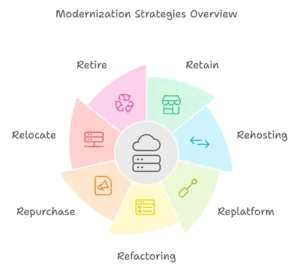The 7 R’s of Application Modernization: Your Strategic Roadmap to Digital Transformation
Listen to the blog

As the enterprise tech stack evolves, businesses face mounting pressure to modernize their legacy applications. But with technology investments running into millions of dollars, choosing the right modernization strategy isn’t just an IT decision—it’s a critical business move. Enter the 7 R’s framework: a comprehensive approach that’s revolutionizing how enterprises tackle application modernization.
Understanding Your Options: The 7 R’s Decoded

- The retain strategy, often overlooked but strategically vital, involves keeping applications in their current state. While it might seem counterintuitive in a modernization discussion, some legacy applications continue to deliver value and meet compliance requirements without needing immediate changes. Major banks, for instance, often retain their COBOL-based core banking systems that have proven reliable for decades.
- Rehosting, commonly known as “lift and shift,” represents the fastest route to cloud migration. This approach moves applications to modern infrastructure with minimal changes to the code. Companies typically reduce operational costs by 30% through rehosting alone, making it an attractive first step in modernization journeys.
- The replatform approach strikes a balance between speed and optimization. Think of it as “lift, tinker, and shift.” Companies modify their applications just enough to take advantage of cloud benefits without complete rewrites.
- Refactoring stands as the most transformative option, involving significant code modifications to fully exploit modern technologies. While demanding more resources upfront, refactoring can dramatically improve scalability and performance.
- The repurchase strategy acknowledges that sometimes, building isn’t the answer. Moving to commercial SaaS solutions can offer immediate access to modern features and regular updates. Many organizations have successfully replaced legacy systems with modern commercial SAAS platforms, achieving faster ROI than through custom development.
- Relocating applications to different data centers or cloud providers represents a strategic shift in hosting without necessarily changing the applications themselves. This approach has gained traction as companies adopt multi-cloud strategies to optimize costs and reduce vendor lock-in.
Finally, the retire strategy requires courage but often yields the highest ROI. Industry data suggests that up to 20% of an enterprise’s application portfolio provides minimal business value and should be decommissioned. Savings from decommissioning applications are seen in labor savings, license maintenance cost elimination and infrastructure repurposing and storage savings. Solix has a strong offering for those that decide to retire applications: SOLIXCloud Application Retirement | Retire Apps, Cut Costs
Making the Right Choice
Success in application modernization doesn’t come from blindly applying these strategies—it demands careful analysis of business value, technical debt, and organizational readiness. The key lies in creating a balanced portfolio approach where different applications might require different strategies.
Forward-thinking organizations are increasingly adopting multiple R’s in their modernization journeys. A major retailer recently modernized its e-commerce platform by replatforming the front-end customer interface while retaining its battle-tested backend order processing system. This hybrid approach delivered immediate benefits while managing risk and cost.
The Bottom Line
As technology continues to evolve at breakneck speed, the 7 R’s framework provides a structured approach to modernization decisions. Whether you’re dealing with monolithic legacy systems or looking to optimize cloud-native applications, understanding and correctly applying these strategies can mean the difference between digital transformation success and expensive failure.
Smart business leaders recognize that application modernization isn’t a one-time project but an ongoing journey. By leveraging the 7 R’s framework, organizations can make informed decisions that balance innovation with pragmatism, ensuring their technology investments drive real business value in an increasingly competitive digital landscape.
Stephen Tallant
As the Director of Product Marketing at Solix Technologies, I lead the development and communication of the product and solution story to the market. I have over 25 years of experience in product marketing and product management, creating engaging messaging, launch plans, collateral, and content for various software solutions. I live in metro Philadelphia, and am a big sports fan - so much so, I sit on the Board of the Philadelphia Sports Hall of Fame. I attended Villanova University for both my undergraduate and graduate degrees.
